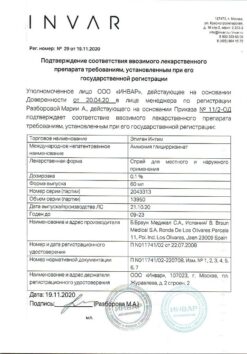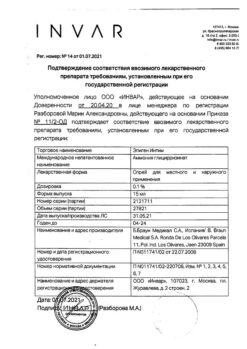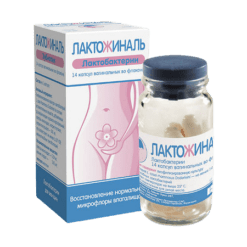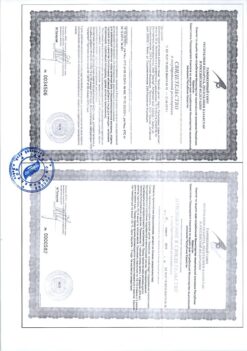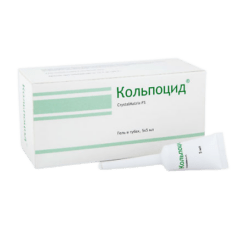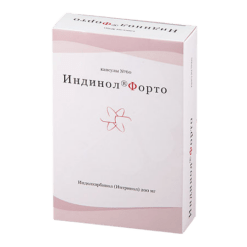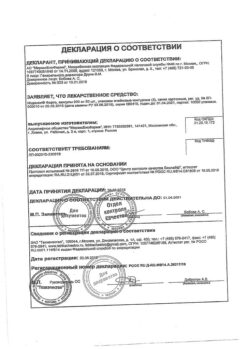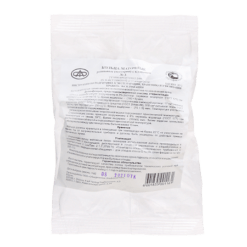No products in the cart.
Juno Bio-T Cu T-shaped intrauterine contraceptive coil
€8.03 €7.03
EAN: 4811379000043
SKU: 222949
Categories: Contraceptive, Gynecology and Obstetrics, Medicine, Spiral
Description
- The ‘Juno Bio-T’ contraceptive is a classic model of the T-shaped medical IUD.
- The anchor is made of high pressure polyethylene and is shaped with preset mechanical characteristics. The horizontal arms of the IUD end in olives. A copper wire is placed around the vertical rod. At the end of the rod there is a loop for attaching two transcervical strands.
- Length of the anchor 36 mm, width 32 mm. The area of the copper braid is 380 mm.
- Copper coating purity of 99.998%, diffusion rate of Cu2+10-15 µg/day.
- The VMS is supplied in a blister pack complete with a 4.5 mm diameter polymeric introductory tube and a piston. The insertion tube has a removable plastic stop to indicate the insertion depth of the product and the direction of the arm opening plane.
- Sterilisation – gamma irradiation.
- Maximum duration of use: 5 years.
- Recommended insertion technique – ‘withdrawal’ method.
- The distinctive feature of the IUD of series ‘Juno Bio-T’ is the preservation of a constant and independent of the contractions of the uterus, the force at the points of contact of the arms of the contraceptive and the endometrium, this ensures an optimal spatial position of the product in the uterine cavity (high standing of the contraceptive and its pressing against the uterine bed during physiological contractions).
Indications
Indications
Not expecting pregnancy.
Treatment and prevention of Asherman’s syndrome.
As a post-coital means, the Juno Bio-T series IUD can be inserted within 3-4 days after unprotected sexual intercourse.
Pharmacological effect
Pharmacological effect
The contraceptive ‘Junona Bio-T’ is a classic model of a T-shaped medicated IUD.
The anchor is made of high-density polyethylene and has a shape with specified mechanical characteristics. The horizontal shoulders of the IUD end in olives. Copper wire is placed around the vertical rod. At the end of the rod there is a loop for attaching two transcervical threads.
Armature length 36 mm, width 32 mm. The copper braid area is 380 mm.
The degree of purification of the copper coating is 99.998%, the diffusion rate of Cu2+ ions is 10-15 μg/day.
The IUD is supplied in blister packaging complete with a 4.5 mm diameter polymer insertion tube and piston. The insertion tube has a movable plastic limiter to indicate the depth of insertion of the product and the direction of the opening plane of the armature hangers.
Sterilization – gamma irradiation.
Maximum duration of use: 5 years.
The recommended injection technique is the ‘withdrawal’ method.
A distinctive feature of the IUD of the ‘Juno Bio-T’ series is the preservation of a constant and independent of uterine contractions force at the points of contact of the contraceptive shoulders and the endometrium, which ensures optimal spatial location of the device in the uterine cavity (high standing of the contraceptive and its pressing to the fundus of the uterus during physiological contractions).
Special instructions
Special instructions
Intrauterine contraception is the insertion of small devices (IUDs) into the uterine cavity.
The period of adaptation of the body to the IUD lasts about 3 months. Immediately after installation of the intrauterine contraceptive, you may be bothered by slight bleeding from the genital tract, slight pain in the lower abdomen, which should go away in 2-3 days. To relieve pain, you can take 1-2 tablets of analgin or aspirin. For 8-10 days it is necessary to abstain from sexual activity, increased physical activity, sports, visiting the bathhouse, sauna.
Even if you feel well, after 10 days you should contact the doctor who inserted the IUD.
Within 2-3 months after insertion of the IUD into the uterus, periods may be heavier and longer, and sometimes there is slight bleeding from the genital tract between menstrual bleeding. During menstruation, it is advisable to pay attention to sanitary pads in order to notice in time that the device falls out with menstrual flow.
You should undergo repeated examinations with a gynecologist 1, 3, 6 months after the introduction of an intrauterine contraceptive, then 1-2 times a year during the entire period of use of the IUD.
When using intrauterine contraception, you must follow the usual hygienic regime.
However, as with any modern method of birth control, complications may arise:
delayed menstruation (pregnancy can occur very rarely)
pain in the lower abdomen, pain during sexual intercourse, increased body temperature, unusual discharge from the genital tract (signs of the development of inflammatory diseases of the genital organs); after three months, menstruation remains long and heavy, weakness and a feeling of malaise have appeared (signs of impaired adaptation to the IUD).
If these signs appear, you should consult a doctor immediately.
After the expiration of the period of use of the IUD, which was indicated to you by your doctor, the contraceptive must be removed. If you like this method of contraception and would like to continue it, after a preliminary examination on the day of removal of the ‘old’ IUD, you can install a new one.
Remember that you can remove the intrauterine device at any time you wish. This method of birth control does not affect reproductive function (pregnancy can occur immediately after removal of the IUD, regardless of the duration of its use).
The IUD is easily and painlessly removed from the uterus, but you should not do it yourself.
Contraindications
Contraindications
Pregnancy (suspected or confirmed), malignant diseases of the female genital organs, inflammatory processes of the pelvic organs, bleeding from the genital organs of unknown etiology, abnormal development of the uterus, fibroids for more than 8 weeks, endometriosis of any localization, allergy to copper.
The IUD should be used with caution in case of a high risk of developing sexually transmitted diseases (presence of several sexual partners), anemia (hemoglobin less than 90 g/l), in nulliparous women, with blood diseases, in patients with a history of ectopic pregnancy.
Prescribing
Prescribing
A woman’s desire to protect herself from pregnancy.
Treatment and prevention of Asherman’s syndrome.
As a post-coital means, the Yuno Bio-T series IUD can be inserted within 3-4 days after unprotected intercourse.
Storage conditions
Storage conditions
Store in a dry place, protected from light.
Manufacturer
Manufacturer
Simurg, Russia
Additional information
| Conditions of storage | Store in a dry place protected from light. |
|---|---|
| Manufacturer | Simurgh, Russia |
| Brand | Simurgh |
Related products
Buy Juno Bio-T Cu T-shaped intrauterine contraceptive coil with delivery to USA, UK, Europe and over 120 other countries.



